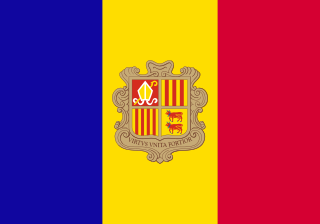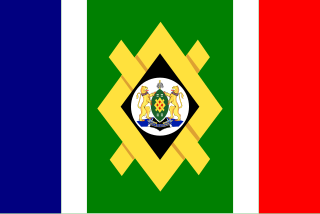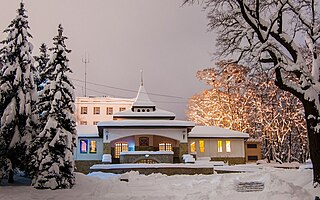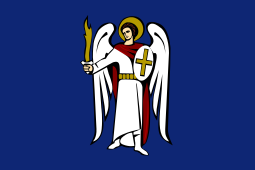
The national flag of the Russian Federation is a tricolour of three equal horizontal fields: white on the top, blue in the middle, and red on the bottom. It was first raised in 1696, as an ensign for merchant ships under the Tsardom of Russia.

The national flag of the Principality of Andorra features a vertical tricolour of blue, yellow, and red with the coat of arms of Andorra in the center. Although the three vertical bars may at first appear to be of equal width, the centre yellow bar is slightly wider than the other two so that the ratio of bar widths is 8:9:8 with an overall flag ratio of 7:10.

The national flag of Ukraine consists of equally sized horizontal bands of blue and yellow.

The coat of arms of Ukraine is a blue shield with a golden trident. It is colloquially known as the tryzub.

The Patriarchal cross is a variant of the Christian cross, the religious symbol of Christianity, and is also known as the Cross of Lorraine. Similar to the familiar Latin cross, the patriarchal cross possesses a smaller crossbar placed above the main one so that both crossbars are near the top. Sometimes the patriarchal cross has a short, slanted crosspiece near its foot. This slanted, lower crosspiece often appears in Byzantine Greek and Eastern European iconography, as well as in other Eastern Orthodox churches. In most renditions of the Cross of Lorraine, the horizontal bars are "graded" with the upper bar being the shorter, though variations with the bars of equal length are also seen.

The coat of arms of Russia derives from the earlier coat of arms of the Russian Empire. Though modified more than once since the reign of Ivan III (1462–1505), the current coat of arms is directly derived from its medieval original, with the double-headed eagle having Byzantine and earlier antecedents. The general tincture corresponds to the fifteenth-century standard.

The coat of arms of Kyiv features the Archangel Michael officially named as "Saint Michael the Archistrategos", wielding a flaming sword and a shield on an azure field.

The current design of the flag of Johannesburg was adopted on 16 May 1997, replacing a previous version of the flag that had been in service since 20 October 1970.

Korosten is a historic city and a large transport hub in the Zhytomyr Oblast (province) of northern Ukraine. It is located on the Uzh River. Korosten serves as the administrative center of the Korosten Raion (district) . As of January 2022 Korosten's population was approximately 61,496.

The coat of arms of the Georgian Soviet Socialist Republic was adopted on May 20, 1921 by the government of the Georgian Soviet Socialist Republic. The coat of arms is loosely based on the coat of arms of the Soviet Union. It shows symbols of agriculture. The red star rising above the Caucasus stands for the future of the Georgian nation, and the hammer and sickle for the victory of Communism and the "world-wide socialist community of states".

The State Emblem of the Tajik Soviet Socialist Republic was adopted on March 1, 1937 by the government of the Tajik Soviet Socialist Republic. The emblem is based on the State Emblem of the Soviet Union. It shows symbols of agriculture. The red star is prominently featured with a small hammer and sickle within it. The rising sun stands for the future of the Tajik nation, and the star as well as the hammer and sickle for the victory of communism and the "world-wide socialist community of states". The emblem was replaced with the new emblem in 1992, which uses a similar design to the Soviet one. It was, however, was replacing the red banner with the current national flag, the big red star was replaced by the mountains, represents Pamir, the Samanid dynasty crown, and added the Quran book at below. It represents Islam as the official religion.

The emblem of the Uzbek Soviet Socialist Republic was adopted on February 14, 1937 by the government of the Uzbek Soviet Socialist Republic. The emblem is based on the emblem of the Soviet Union. It shows symbols of agriculture and heavy industry (hammer). The rising sun over a map of the Soviet Central Asia symbolizes the future of this region, while the five pointed red star stands for the "socialist revolution on all five continents".

The coat of arms of Tiraspol is the official coat of arms of the city of Tiraspol. Tiraspol is the capital of Transnistria, an unrecognized breakaway republic internationally recognized as part of Moldova. Since 2018, two coats of arms of the city are used: the original imperial one and the Soviet one.
The symbols of Brussels are the objects, images, or cultural expressions that are emblematic, representative, or otherwise characteristic of Brussels or Brussels culture. As a rule, these national symbols are cultural icons that have emerged from Brusselian folklore and tradition, meaning few have any official status. However, most if not all maintain recognition at a national or international level, and some, such as the flag of the Brussels-Capital Region, have been codified in, and are established, official, and recognised symbols of Brussels.

The national flag of Mexico is a vertical tricolor of green, white, and red with the national coat of arms charged in the center of the white stripe. While the meaning of the colors has changed over time, these three colors were adopted by Mexico following independence from Spain during the country's War of Independence, and subsequent First Mexican Empire.

The emblem of the Russian Soviet Federative Socialist Republic (RSFSR) was adopted on 10 July 1918 by the government of the Russian Soviet Federative Socialist Republic, and modified several times afterwards. It shows wheat as the symbol of agriculture, a rising sun for the future of the Russian nation, the red star as well as the hammer and sickle for the victory of communism and the "world-wide socialist community of states".

The coat of arms of Nizhny Novgorod is the official symbol of the city from December 20, 2006.

The flag of Riga is one of the official symbols of Riga, along with the coat of arms of Riga. The flag consists of a horizontal bicolour of blue and white, with the coat of arms of Riga in the middle.

The coat of arms of Sevastopol is a heraldic symbol representing the city of Sevastopol, Crimea. It is featured in the middle of the flag of Sevastopol on a red background.
This is a list article about flags that have been used by pro-Russian separatists in Ukraine and in areas occupied by Russia and Russian-controlled forces during the Russo-Ukrainian War.


















